How Much Does it Cost to Migrate to Shopify?

Your decision to migrate to Shopify is undoubtedly triggered by a list of factors. Maybe your current eCommerce platform is lacking growth options, you’re seeking advanced features, or looking to change your design goals.
Whatever reasons you have, the main question that is stuck in your mind is “What will be the cost of migration?”. And this blog will surely answer that.
To ensure a successful transition to Shopify, you really should have your base clear. So, we’ll start by discussing some basic doubts that you may have at this point. If you’re curious to uncover costs associated with Shopify migration, you can check the table of contents and jump right there.
And here, we’ll start with the basics.
What is Shopify?

Shopify is an all-in-one eCommerce platform with a highly user-friendly interface, the best tools, features, robust scalability options, and more that no other platform can match.
This is an easy-to-use platform, where you can create your store independently, tweak website design using its drag-and-drop functionality, and much more — without requiring technical knowledge. Moreover, Shopify has a wide range of built-in tools that allow businesses to manage inventory, process payments, and track sales in the right way.
If you’re skeptical about whether Shopify is the right choice for you, I assure you that your decision to migrate to Shopify is well worth your excitement.
What are the benefits you get while migrating to Shopify? Let’s discuss them.
Why You Should Migrate to Shopify?
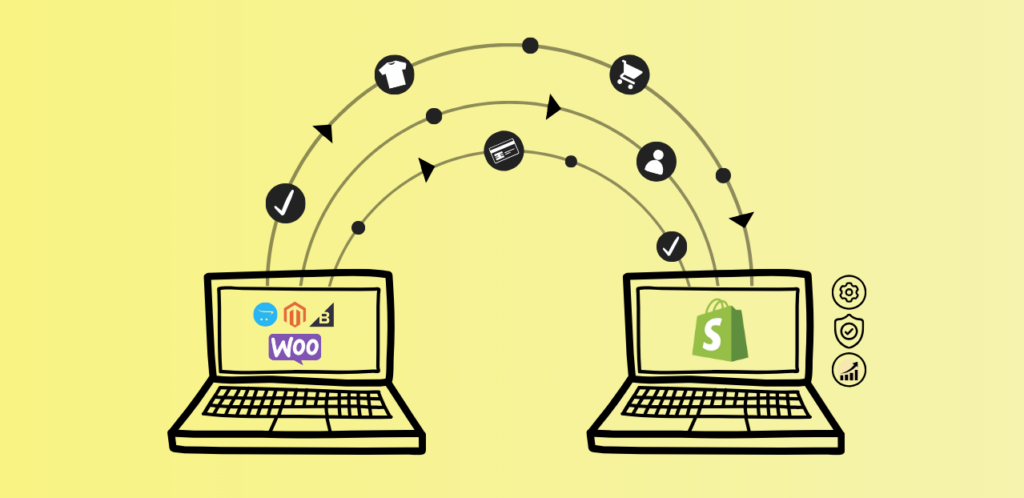
There is a multitude of eCommerce platforms to choose from, and each of them has unique offerings. However, I see no doubt in stating that Shopify is the best among them. This is evident, as over 4 million businesses worldwide rely on Shopify for online sales.
These businesses chose Shopify because of its flexibility and reliability. If you’re thinking of migrating your eCommerce store, Shopify deserves to top your priority list of platforms. Let me list some reasons to prove it.
1. Shopify is Cost-effective
I first discussed its ‘cost-effectiveness’ because every person considers cost before making a purchase — and online store owners (like you) are no different.
First of all, let me mention that Shopify provides subscription packages for creating a store.
When you’re working with platforms other than Shopify, you have to consider expenses such as server costs, hosting fees, security, payment processing, and more. Instead, Shopify offers an end-to-end cloud-hosted service that allows you to easily plug and play your eCommerce store, starting at just $29 per month.
2. Shopify is Easy to Set Up and Customize
Shopify was designed to be user-friendly. Even if you don’t have any previous experience with eCommerce platforms or coding languages such as HTML or CSS, you can set up your Shopify site without expert help.
Not only does Shopify offer a seamless setup, but it also provides a variety of templates that you can customize according to your brand. It has a drag-and-drop builder, one of its big benefits, that simplifies the entire customization process. On top of that, the Shopify app store allows you to reach extensive levels of customization.
3. Shopify has Scalability Options
We don’t just prefer Shopify blindly. Shopify is built for all business sizes. So, it doesn’t matter if you’re facing growth issues with your current platform or looking to reach the next level of customization; Shopify can provide you with stability when your business expands.
And it requires no extra effort— all you need to do is subscribe to an appropriate plan, whether an Advanced Shopify Plan or a Shopify Plus Plan.
4. Shopify is Secure and Reliable
As we mentioned earlier, Shopify hosts your store on its server and ensures both, store security and your peace of mind. Unlike self-hosted platforms like WordPress and Magento, you don’t have to worry about maintaining your server security – Shopify itself will take care of it.
The platform always keeps its security systems up to date with best practices, and all you have to do is keep an eye on Shopify updates to stay informed and secure.
All these were the main reasons why eCommerce store owners are choosing to migrate to Shopify, but the list doesn’t end here. Many other reasons prove Shopify to be the best eCommerce platform. Here I’ve listed them.
- Shopify Community contains great value; supporting store owners whenever facing issues
- Shopify Plus is the best new addition that Shopify introduced for enterprise-sized businesses
- Apart from subscription fees, Shopify has almost no hidden costs
- Shopify is super SEO-friendly and has great performance abilities
- Personalization with Shopify is easy
- Lastly, the product management system in Shopify makes it easy for merchants to manage inventory
And that was it. We saw each reason that makes Shopify the right choice for you. Now comes a stressful part — moving to Shopify.
You’re probably scared thinking it will be a long daunting process. But believe me, professionally moving to Shopify will make your migration process easier and worry-free.
With that, let’s start to understand how long it takes.
How Long Does it Take to Migrate to Shopify?
The clearest answer I can present is, that the bigger the store, the longer it will take.
If you ask, why is that? Let me tell you why.
The Shopify migration process is all about exporting and importing store data from one platform to Shopify. Ultimately, the time consumed will depend on the size of the data that your store contains, including the number of products, customer data, order histories, and the complexity of customizations.
- If your store size is small to medium, and the quantity of data and functionality is minimal, Shopify migration may take you around 5-7 days.
- If your store size is medium-enterprise sized, and your store contains a huge quantity of data and functionality, Shopify migration will take you around 4-6 weeks.
There are a lot of moving parts, and the process may be complex, so I suggest you hire a Shopify expert to work on your store migration — as they can make a huge difference.
Here is the migration process that we follow and it consists of 5 steps.
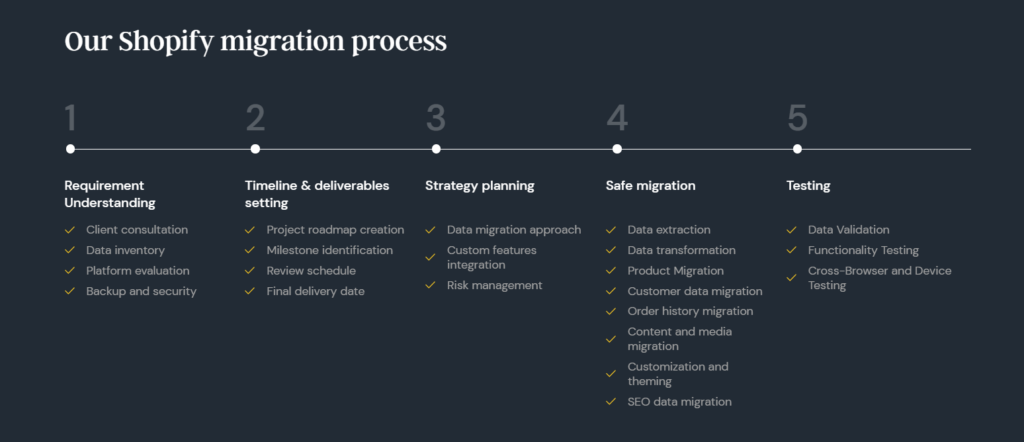
Following this process, we offer a seamless migration to Shopify within 14 days.
Now that we have gained an understanding of how long the migration will take, let’s move on to the main question you’re looking answers for — the price tag of Shopify migration.
How Much Does it Cost to Migrate to Shopify?
There is ‘No Fixed Amount’ when you migrate your website to the Shopify platform.
Instead, there’s a range of costs associated with Shopify migration, and here’s the list:
- Shopify Subscription Fees
- Store Migration Cost
- Shopify Store Set Up and Redesign Cost
- Domain Name Fees
In this section, we’ll provide an in-depth breakdown of each of these costs that come into play during the migration process.
Let’s start. 👇
1. Shopify Subscription Fees
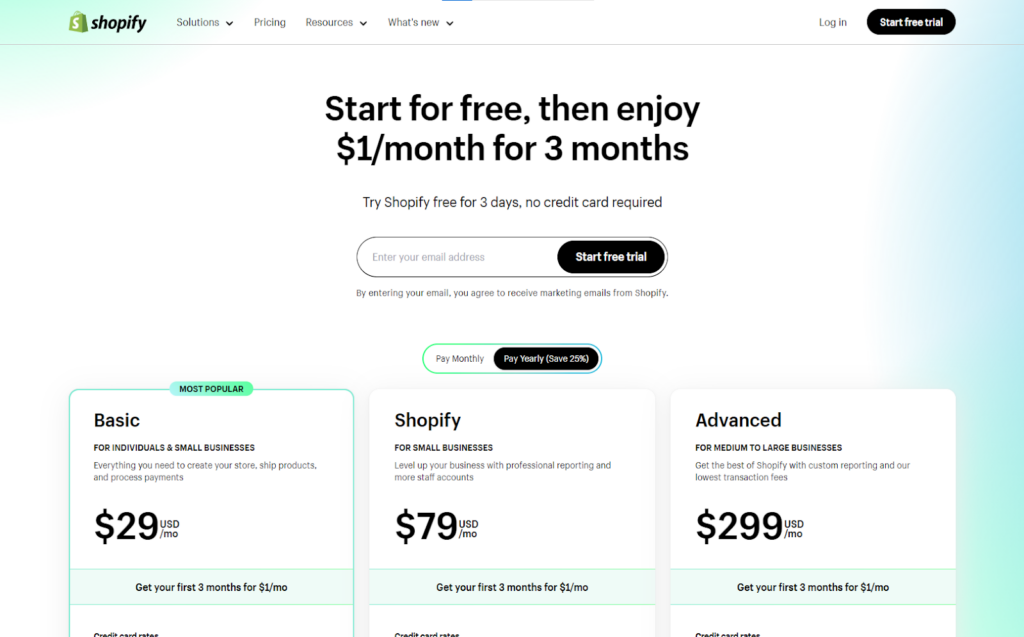
As mentioned earlier, Shopify operates on monthly subscription packages, making it the first cost to consider when you move to Shopify. If you ask which subscription plan will be the right choice for you, the answer is – it will depend on your business size and the functionalities required.
Here I’m adding a table that includes pricing plans of Shopify and specifies the business sizes for which they work best.
| List of Plans Provided | Plan Pricing | Best for |
| Basic Shopify Plan | $29 per month | Individuals and small businesses |
| Shopify Plan | $79 per month | Small businesses |
| Advanced Shopify Plan | $299 per month | Medium to large sized businesses |
| Shopify Plus | $2000 per month | Enterprise sized businesses |
You can compare Shopify plan pricing models to choose one that fits well your store size and budget. Till then, let’s move on to understand another cost associated when transitioning to Shopify.
2. Store Migration Cost

Once you’ve purchased your subscription on Shopify, the next cost you’ll meet is data migration cost. You’ll need to migrate all your data to Shopify, and most likely, unless your store has a very minimal amount of data, you’ll need a Shopify developer to help you with the process.
Here’s a straightforward breakdown of the costs that might be charged by experts.
Cost of Hiring Shopify Expert for Migration:
- Fixed Rate: $10,000 to $20,000
- Hourly Basis: Around $20 to $55 per hour
Moreover, if your store size is small and has a lesser amount of data, you can choose to migrate data independently. There is a variety of free and paid migration apps available on the Shopify app store, and consider the costs coming with it.
It’s necessary to note that these figures will vary depending on various factors, such as your niche, store complexity, store size, duration of the process, and the experience level of Shopify developers that you hire. And you always have the option to choose that fits your requirements and budget.
You know that the migration process doesn’t conclude once store data is transferred. It involves migrating store functionalities as well, necessitating the set-up and redesign of your entire store on Shopify.
And that will also involve expenses, so let’s check them out.
3. Shopify Store Set Up and Redesign Cost
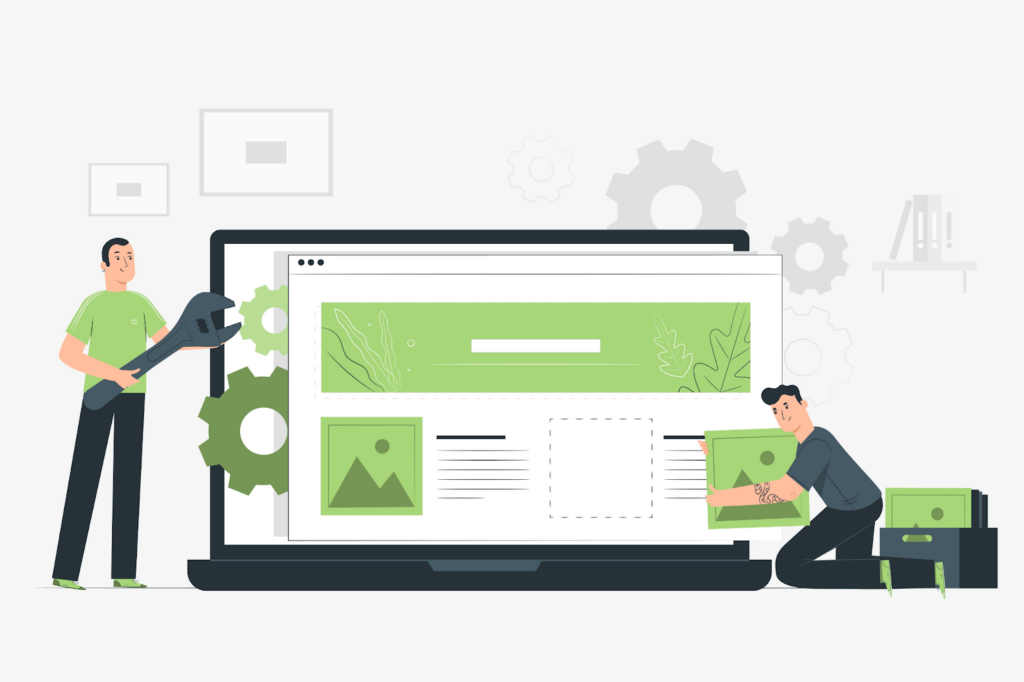
Firstly, you’ll need a theme to kickstart your Shopify journey. And for additional functionalities, you’ll find a range of Shopify Apps within its ecosystem.
Below I’ve added a breakdown of costs that you might face during the set-up and redesign of your store on Shopify.
Average Cost of Shopify Themes:
Shopify offers free themes for its users. However, premium themes are also available, generally costing between $180 – $350.
Average Cost of Shopify Apps:
Shopify app store offers over 6000+ apps for user convenience, which includes both free and premium ones. The average cost of premium apps on the Shopify platform is nearly $20 per month.
Cost to Set Up or Redesign Your Shopify Website:
Most likely, you’ll need a Shopify expert to assist in setting up your store, especially if you require high-quality customization and seamless integration of Shopify themes and apps. The cost will range between $500 to $25,000, depending on the level of customization needed and the expertise of the developer.
Now, let’s discuss the last cost that you may need to face, in case you’re looking to give your business a fresh start.
4. Domain Name Fees
When you’re looking to give your business an entirely new identity after migration, it will involve the cost of purchasing a domain name. This process involves leaving behind your old domain name and acquiring a new one. For instance, if your store’s initial name was “slurpfinds.net” and you decide on a new name, like “slurpfinds.com”.
And that’s how you encounter the cost of purchasing a new domain name, typically ranging from $10 to $20 per year. However, the cost may increase depending on factors such as the chosen registrar, registration period, and additional features.
And that’s all. It’s time to wrap up our discussion on the costs involved in Shopify migration. I hope you’ve gained a clear idea of each associated cost.
Now that the main topic of the blog “How Much Does Migration Costs” is answered, let’s continue our discussion with additional topics to leave behind any doubts or questions. We’ll start with areas that need your attention during and after migration to ensure a smooth move to Shopify. Afterward, we’ll check on how you can reduce your cost of migration.
Let’s start with it.
Things to Consider When Migrating to Shopify
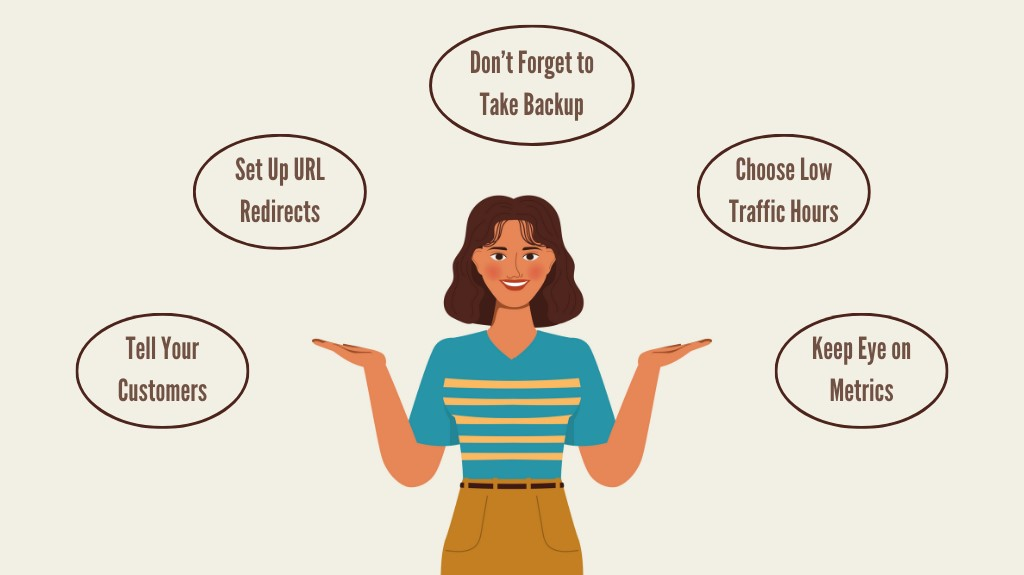
Transitioning to Shopify undergoes several phases. And you need to take each step with extra care and accuracy, as a single mistake can have a big impact on your store operations.
It may result in store downtime, interruption in the checkout journey, website performance drop, or loss of important store data. To avoid such situations, all you need to do is pay extra attention to the aspects I’m explaining below.
1. Start your Migration Process with Store Backup
The migration process no doubt involves risk, making it necessary to start the migration process by taking a complete backup of store data. This way, no matter what twists and turns your migration journey takes, your store will be protected, and you can move forward with peace of mind.
2. Inform Your Customers
What if unexpected performance drops during migration disrupt business operations? It can lead your customers to be frustrated with a high likelihood of losing them forever.
That’s where alerting your audience in advance helps. Sending a prior notice will help you manage customer expectations, as they’ll know that changes are coming and it may lead to potential errors. You can easily notify them through an email or place a visible banner on the homepage, being transparent about the upcoming migration.
3. Migrate During Low Traffic
We saw that the migration process involves the possibility of downtime and poor performance.
Therefore, it is recommended to migrate your website during low-traffic hours. Any issues that arise during this time will impact fewer visitors, and the overall user experience will be preserved.
Additionally, this approach will help Google crawl your site faster since server load and resource demand are significantly lower during low website traffic. It will allow Google’s crawlers to access and index the pages more efficiently.
4. Ensure SEO Isn’t Harmed
During migration, if the store SEO isn’t migrated the right way, you may see a huge drop in your search engine rankings. Conducting a thorough audit post-migration is better, ensuring that all on-page SEO elements such as URLs, meta tags, header tags, and others are intact.
This way, you can promptly solve issues and maintain your hard-earned search engine rankings.
5. Set Up Redirects
When migrating your store to Shopify, changes in URLs, page structures, and overall website organization are common. Consequently, to avoid 404 errors, you’ll need to redirect your old URLs to their corresponding new locations.
Without implementing redirects, your old URLs may turn into dead ends, resulting in a poor user experience and potentially harming your search engine rankings. Moreover, it’s easy to set up redirects from the Shopify admin.
All you need to do is go to Sales Channel >> Online Store >> Navigation. There, you’ll find an option to view URL redirects.

It will provide you with an option to easily import your entire Excel sheet of URLs that you wish to redirect to a new one. Or you can manually add them.
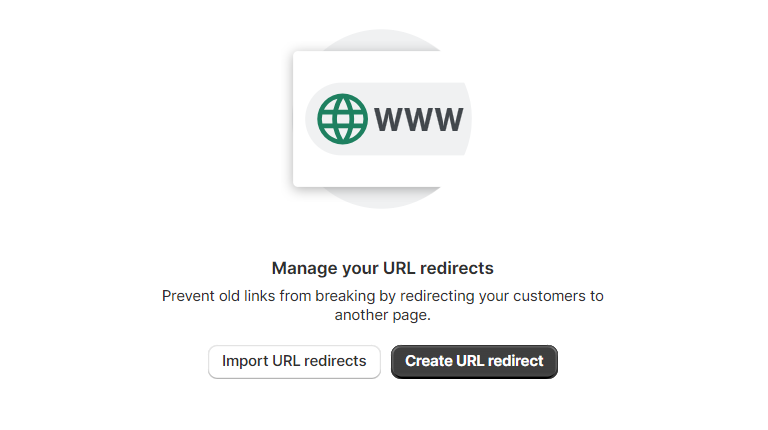
The image that I added below shows how easy it is going to be.
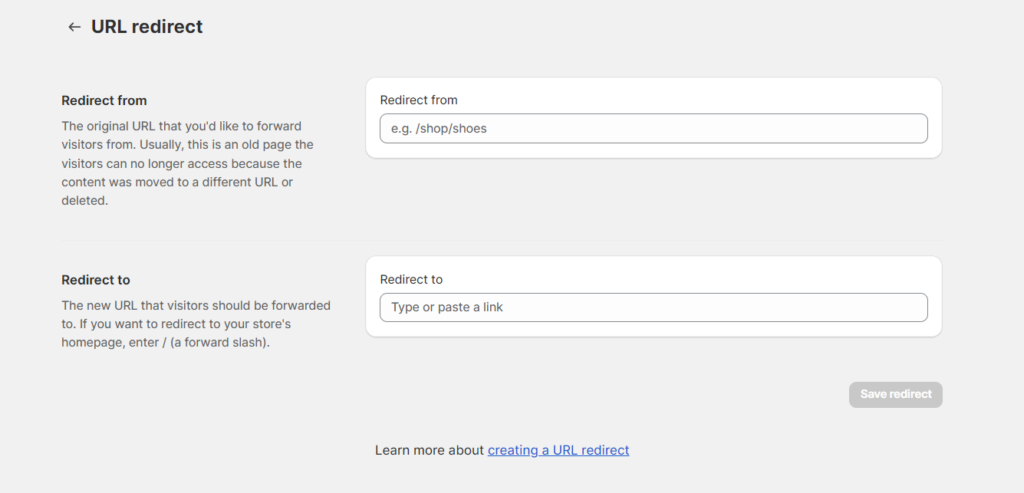
6. Compare Metrics and Analytics Post-Migration
To understand if the migration did a good job of improving your performance and user experience, or at least if it didn’t make things worse, you need to check metrics and analytics once the migration is performed.
You can consider keeping an eye on metrics such as website traffic, conversion rates, and user engagement, with the help of Google Analytics and Google Search Console. They’ll help you gain valuable insights into how well the migration has been executed and whether any adjustments are needed.
These were the areas you can try managing on your own. But still, some tricky parts might cause issues when moving your store to Shopify. So, I suggest hiring Shopify experts to help you with store migration. They understand the potential issues you may face during migration and may offer you great solutions.
It’s always a good idea to have experts on your side as a safety net. Moreover, if budget is your concern while hiring Shopify experts for migration, I have a cure for that. Our next topic explains how you can hire experts on a low budget to reduce the cost of website migration.
Excited? Let’s check it.
How to Hire Shopify Migration Experts within the Budget?
Consider hiring Asia-based Shopify experts.
This is a common suggestion to help you stay within your budget. Being in the eCommerce industry, you may be aware that hiring from Asian countries often costs less than hiring from North America and Western Europe.
To help you compare the cost of hiring from each region, here I’ve added a table that shares the average hourly rates of Shopify experts across the globe.
| Region | Average Hourly Rate |
| North America | $50 – $100+ |
| South America | $20 – $40 |
| Australia | $40 – $85 |
| Western Europe | $40 – $90 |
| Eastern Europe | $20 – $50 |
| Asia | $15 – $40 |
You can spot Asian experts to be more cost-effective than any other region. This is because Asian countries have a low cost of living, and the currency exchange rate will further amplify your cost advantage. If you’re skeptical about work quality, don’t be, as Asian countries like India, Philippines, Japan, and Vietnam have highly skilled Shopify experts to help you migrate your store easily.
For more information: How much does it cost to hire a Shopify expert?
Now, to make your hiring process even easier, let me introduce you to one of the best expert solutions that falls right within your budget.
Aureate Labs is Cost-effective for Shopify Migration!
We Aureate Labs, are an Asia-based eCommerce development agency with over 10 years of expertise in Shopify development.
When it comes to store migration, what sets us apart is not just our competitive pricing but also our commitment to delivering high-quality work. We understand the challenges lying in the migration process and offer a smooth transition to the new Shopify store within 2 weeks — all while ensuring the preservation of your data, SEO, and overall online presence.
For more information, you can visit our Shopify Migration Services page. Or contact our Shopify experts right away.
Final Words
Shopify is the best choice for platform migration—it is versatile, cost-effective, and highly customizable. If you’re seeking ease of use, hassle-free customization, and reduced dependency on developers, you can no doubt migrate to Shopify.
I hope that your main concerns regarding the ‘Cost of Migration’ were clearly explained in this blog. If you have any doubts, don’t hesitate to drop a comment below. We are eager to help you.






Post a Comment
Got a question? Have a feedback? Please feel free to leave your ideas, opinions, and questions in the comments section of our post! ❤️